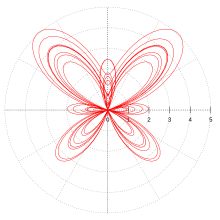
Back معادلة وسيطية Arabic Equació paramètrica Catalan Parametrizace Czech Parameterfremstilling Danish Parameterdarstellung German Παραμετρικές εξισώσεις Greek Ecuación paramétrica Spanish معادله پارامتری FA Équation paramétrique French תיאור פרמטרי של עקום HE

In mathematics, a parametric equation expresses several quantities, such as the coordinates of a point, as functions of one or several variables called parameters.[1]
In the case of a single parameter, parametric equations are commonly used to express the trajectory of a moving point, in which case, the parameter is often, but not necessarily, time, and the point describes a curve, called a parametric curve. In the case of two parameters, the point describes a surface, called a parametric surface. In all cases, the equations are collectively called a parametric representation,[2] or parametric system,[3] or parameterization (alternatively spelled as parametrisation) of the object.[1][4][5]
For example, the equations form a parametric representation of the unit circle, where t is the parameter: A point (x, y) is on the unit circle if and only if there is a value of t such that these two equations generate that point. Sometimes the parametric equations for the individual scalar output variables are combined into a single parametric equation in vectors:
Parametric representations are generally nonunique (see the "Examples in two dimensions" section below), so the same quantities may be expressed by a number of different parameterizations.[1]
In addition to curves and surfaces, parametric equations can describe manifolds and algebraic varieties of higher dimension, with the number of parameters being equal to the dimension of the manifold or variety, and the number of equations being equal to the dimension of the space in which the manifold or variety is considered (for curves the dimension is one and one parameter is used, for surfaces dimension two and two parameters, etc.).
Parametric equations are commonly used in kinematics, where the trajectory of an object is represented by equations depending on time as the parameter. Because of this application, a single parameter is often labeled t; however, parameters can represent other physical quantities (such as geometric variables) or can be selected arbitrarily for convenience. Parameterizations are non-unique; more than one set of parametric equations can specify the same curve.[6]
- ^ a b c Weisstein, Eric W. "Parametric Equations". MathWorld.
- ^ Kreyszig, Erwin (1972). Advanced Engineering Mathematics (3rd ed.). New York: Wiley. pp. 291, 342. ISBN 0-471-50728-8.
- ^ Burden, Richard L.; Faires, J. Douglas (1993). Numerical Analysis (5th ed.). Boston: Brookes/Cole. p. 149. ISBN 0-534-93219-3.
- ^ Thomas, George B.; Finney, Ross L. (1979). Calculus and Analytic Geometry (fifth ed.). Addison-Wesley. p. 91.
- ^ Nykamp, Duane. "Plane parametrization example". mathinsight.org. Retrieved 2017-04-14.
- ^ Spitzbart, Abraham (1975). Calculus with Analytic Geometry. Gleview, IL: Scott, Foresman and Company. ISBN 0-673-07907-4. Retrieved August 30, 2015.

